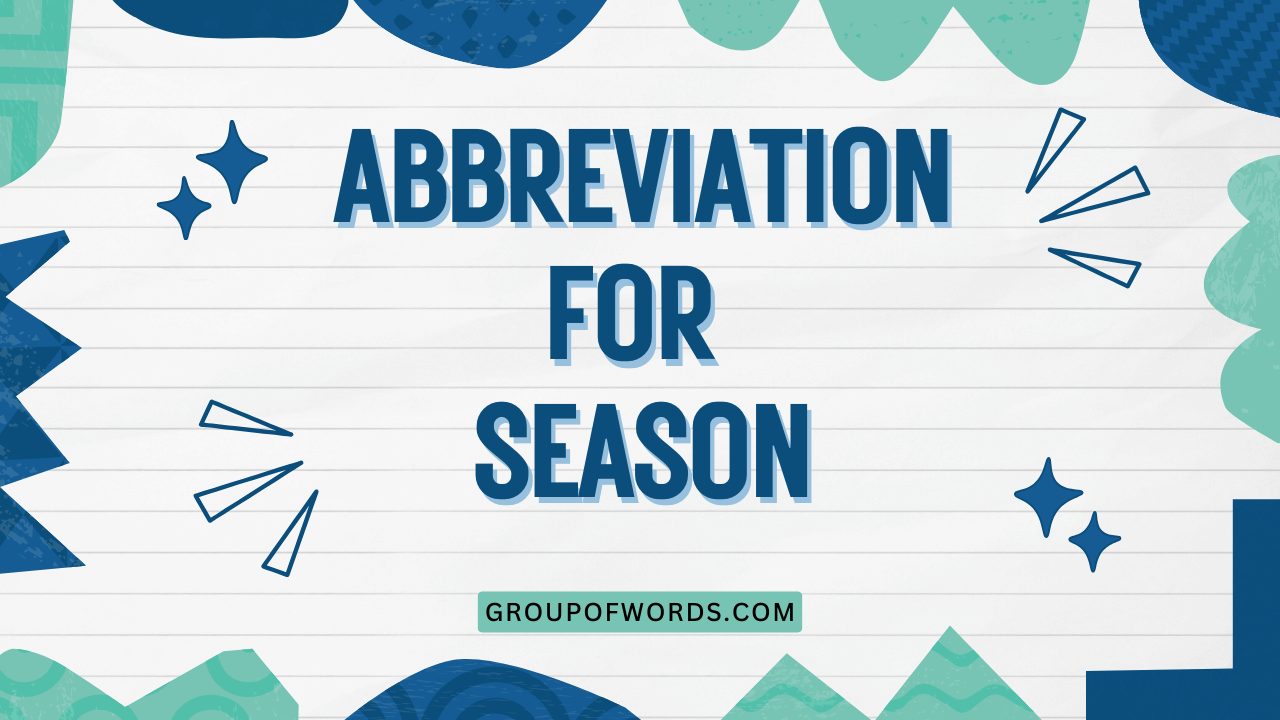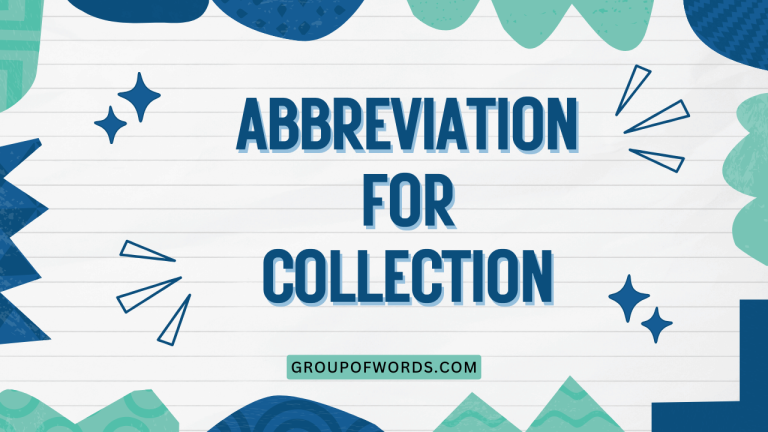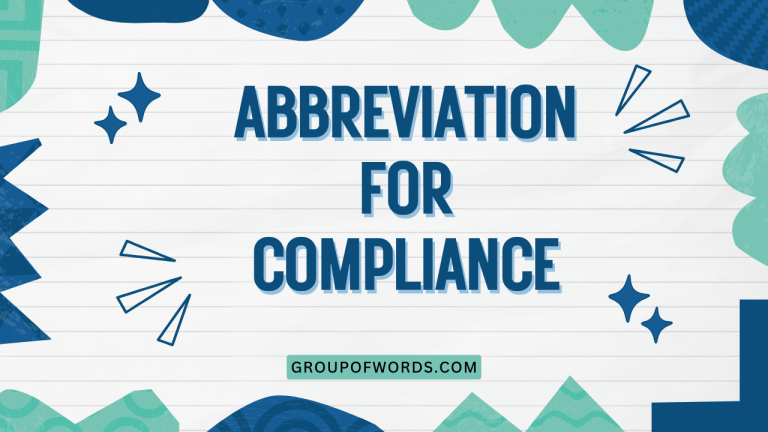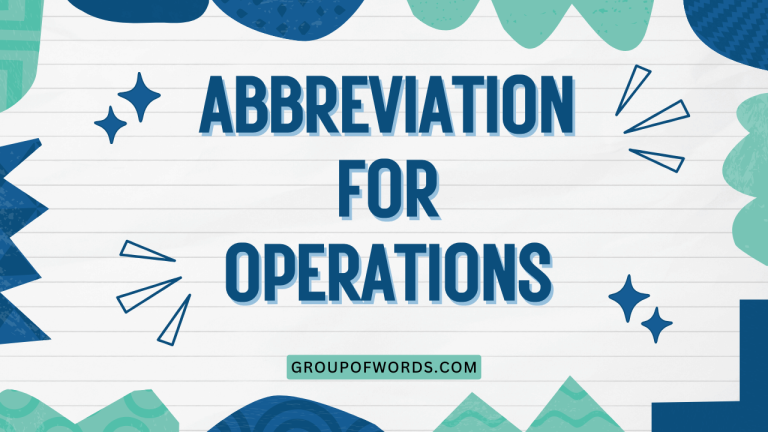Abbreviations for Seasons: A Comprehensive Guide
Understanding how to abbreviate the seasons—spring, summer, autumn (or fall), and winter—is a fundamental aspect of English writing. These abbreviations are commonly used in calendars, schedules, weather reports, and various forms of documentation to save space and enhance clarity.
This guide provides a thorough exploration of the abbreviations for each season, their proper usage, and common pitfalls to avoid. Whether you are a student, a professional, or simply someone looking to improve your English grammar skills, this article will equip you with the knowledge and confidence to use season abbreviations correctly and effectively.
Table of Contents
- Introduction
- Definition of Season Abbreviations
- Structural Breakdown
- Types and Categories of Season Abbreviations
- Examples of Season Abbreviations
- Usage Rules for Season Abbreviations
- Common Mistakes with Season Abbreviations
- Practice Exercises
- Advanced Topics
- Frequently Asked Questions
- Conclusion
Definition of Season Abbreviations
An abbreviation is a shortened form of a word or phrase, used to represent the full form in a more concise manner. Season abbreviations are specific instances of this, where the names of the four seasons—spring, summer, autumn (or fall), and winter—are shortened for convenience.
These abbreviations are typically used in contexts where space is limited or when the full word is deemed unnecessary for clarity. The primary function of these abbreviations is to save space and time while still conveying the intended meaning.
The use of abbreviations for seasons is common in various contexts, including calendars, weather forecasts, academic schedules, and business reports.
Season abbreviations are classified as initial abbreviations, since they are usually formed by taking the first three letters of the word, although there are variations. Their function is primarily to provide a shorter, more efficient way to refer to a specific season. The contexts in which these abbreviations are used often include situations where brevity is valued, such as in charts, tables, and short-form writing. For instance, a weather forecast might use “Spr.” for spring to conserve space in a visual display. Similarly, an academic calendar might use “Sum.” for summer to save space in a printed schedule. Understanding the definition and function of season abbreviations is essential for effective communication in various written formats. The correct use of these abbreviations demonstrates attention to detail and adherence to standard English writing conventions.
Structural Breakdown
The structure of season abbreviations is relatively straightforward. Typically, the first three letters of the season’s name are used.
However, there are slight variations depending on the season and the context. For example, “Spring” is often abbreviated as “Spr,” while “Summer” is abbreviated as “Sum.” “Autumn” and “Winter” follow a similar pattern, with “Aut” and “Win” respectively.
In American English, “Fall” is often used instead of “Autumn,” and is abbreviated as “Fall.” Let’s break down each season’s abbreviation:
- Spring: Usually abbreviated as “Spr.”
- Summer: Usually abbreviated as “Sum.”
- Autumn/Fall: “Autumn” is abbreviated as “Aut.” or “Fall” is abbreviated as “Fall.”
- Winter: Usually abbreviated as “Win.”
The structural breakdown also includes the use of a period after the abbreviation. In many contexts, a period is used to indicate that the word has been abbreviated.
However, the use of a period is not always mandatory, and it often depends on the style guide being followed (e.g., AP Style, MLA Style, Chicago Style). Some style guides prefer the use of periods after abbreviations, while others do not.
It is essential to be consistent in your use of periods throughout a document or piece of writing. For academic writing it is crucial to adhere to the style guidelines of the publication or institution.
The absence or presence of a period does not change the meaning of the abbreviation, but it does affect the overall consistency and professionalism of the writing.
Types and Categories of Season Abbreviations
While the basic structure of season abbreviations is consistent, there are slight variations in how they are used and categorized. The main types or categories include:
Standard Abbreviations
These are the most commonly used abbreviations for the seasons. They are widely recognized and understood in various contexts.
The standard abbreviations are “Spr.” for Spring, “Sum.” for Summer, “Aut.” or “Fall” for Autumn/Fall, and “Win.” for Winter. These abbreviations are suitable for most general writing purposes, including calendars, schedules, and informal communications.
Abbreviations in Tables and Charts
In tables and charts, abbreviations are often used to save space and improve readability. In such cases, the abbreviations may be slightly different from the standard forms.
For example, a table might use “Sp,” “Su,” “Au,” and “Wi” instead of “Spr.,” “Sum.,” “Aut.,” and “Win.” This is done to minimize the amount of space each entry takes up. It’s important to provide a key or legend that explains the abbreviations used in the table or chart to avoid confusion.
Abbreviations in Weather Reports
Weather reports commonly use abbreviations to concisely convey information about seasonal conditions. These abbreviations are usually the standard forms, but they may also be adapted to fit the specific format of the report.
For example, a weather forecast might say, “Spr. showers expected,” or “Win. storm warning.” The use of abbreviations in weather reports helps to quickly communicate essential information to the public. In more informal weather updates, or on social media, abbreviations might be omitted completely for an even more casual tone, such as “Summer heat wave incoming!”
Abbreviations in Academic Calendars
Academic calendars often use season abbreviations to indicate the duration of academic terms or semesters. These abbreviations are typically the standard forms, such as “Spr.
Semester” or “Sum. Session.” The use of abbreviations in academic calendars helps to save space and make the calendar easier to read.
Some institutions might also use abbreviations to denote specific courses or programs offered during each season. For example, “Spr.
ENG 101″ might indicate an English course offered during the spring semester.
Examples of Season Abbreviations
To further illustrate the use of season abbreviations, let’s look at some specific examples in different contexts. The following tables provide examples of how these abbreviations are used in sentences, calendars, weather reports, and academic schedules.
Examples in Sentences
This table provides examples of how season abbreviations are used in full sentences. The abbreviations are used to refer to different seasons in various contexts.
| Full Sentence | Sentence with Abbreviation |
|---|---|
| The flowers bloom beautifully in the spring. | The flowers bloom beautifully in the Spr. |
| We enjoy swimming in the summer. | We enjoy swimming in the Sum. |
| The leaves change color in the autumn. | The leaves change color in the Aut. |
| The leaves change color in the fall. | The leaves change color in the Fall. |
| Snow falls heavily in the winter. | Snow falls heavily in the Win. |
| Spring is my favorite time of year. | Spr. is my favorite time of year. |
| Summer vacation is always a highlight. | Sum. vacation is always a highlight. |
| Autumn brings cooler temperatures. | Aut. brings cooler temperatures. |
| Fall brings cooler temperatures. | Fall brings cooler temperatures. |
| Winter is a time for cozy nights. | Win. is a time for cozy nights. |
| The spring semester begins in March. | The Spr. semester begins in March. |
| Summer courses are offered online. | Sum. courses are offered online. |
| The autumn festival is a popular event. | The Aut. festival is a popular event. |
| The fall festival is a popular event. | The Fall. festival is a popular event. |
| The winter holidays are a festive time. | The Win. holidays are a festive time. |
| We plan a trip every spring. | We plan a trip every Spr. |
| Summer is the perfect time for outdoor activities. | Sum. is the perfect time for outdoor activities. |
| Autumn is known for its vibrant colors. | Aut. is known for its vibrant colors. |
| Fall is known for its vibrant colors. | Fall is known for its vibrant colors. |
| Winter brings a sense of peace and quiet. | Win. brings a sense of peace and quiet. |
| Spring cleaning is a common tradition. | Spr. cleaning is a common tradition. |
| Summer nights are filled with stars. | Sum. nights are filled with stars. |
| Autumn leaves create a beautiful landscape. | Aut. leaves create a beautiful landscape. |
| Fall leaves create a beautiful landscape. | Fall leaves create a beautiful landscape. |
| Winter snow transforms the world into a wonderland. | Win. snow transforms the world into a wonderland. |
Examples in Calendars
This table shows how season abbreviations are used in calendar entries to denote events or activities scheduled during specific seasons.
| Calendar Entry | Explanation |
|---|---|
| Spr. Break: March 15-19 | Spring break is scheduled from March 15th to 19th. |
| Sum. Camp: July 5-30 | Summer camp is scheduled from July 5th to 30th. |
| Aut. Festival: Oct 20 | The autumn festival is scheduled for October 20th. |
| Fall Festival: Oct 20 | The fall festival is scheduled for October 20th. |
| Win. Holiday: Dec 25 | The winter holiday is scheduled for December 25th. |
| Spr. Meeting: April 10 | The spring meeting is scheduled for April 10th. |
| Sum. Workshop: August 1-5 | The summer workshop is scheduled from August 1st to 5th. |
| Aut. Conference: Nov 12-15 | The autumn conference is scheduled from November 12th to 15th. |
| Fall Conference: Nov 12-15 | The fall conference is scheduled from November 12th to 15th. |
| Win. Concert: Dec 20 | The winter concert is scheduled for December 20th. |
| Spr. Training: May 3-7 | The spring training is scheduled from May 3rd to 7th. |
| Sum. Program: June 15-July 15 | The summer program is scheduled from June 15th to July 15th. |
| Aut. Retreat: Sept 25-27 | The autumn retreat is scheduled from September 25th to 27th. |
| Fall Retreat: Sept 25-27 | The fall retreat is scheduled from September 25th to 27th. |
| Win. Party: Dec 31 | The winter party is scheduled for December 31st. |
| Spr. Seminar: April 22 | The spring seminar is scheduled for April 22nd. |
| Sum. School: July 10-Aug 4 | The summer school is scheduled from July 10th to August 4th. |
| Aut. Event: Oct 31 | The autumn event is scheduled for October 31st. |
| Fall Event: Oct 31 | The fall event is scheduled for October 31st. |
| Win. Festival: Dec 15-Jan 1 | The winter festival is scheduled from December 15th to January 1st. |
| Spr. Workshop: May 10-12 | The spring workshop is scheduled from May 10th to 12th. |
| Sum. Institute: June 20-July 20 | The summer institute is scheduled from June 20th to July 20th. |
| Aut. Outing: Sept 30 | The autumn outing is scheduled for September 30th. |
| Fall Outing: Sept 30 | The fall outing is scheduled for September 30th. |
| Win. Gathering: Dec 24 | The winter gathering is scheduled for December 24th. |
Examples in Weather Reports
This table illustrates how season abbreviations are used in weather reports to describe seasonal weather conditions and forecasts.
| Weather Report | Explanation |
|---|---|
| Spr. showers expected tomorrow. | Showers are expected tomorrow during the spring season. |
| Sum. heat wave continues. | The heat wave continues during the summer season. |
| Aut. breezes and cooler temps. | Breezes and cooler temperatures are expected during the autumn season. |
| Fall breezes and cooler temps. | Breezes and cooler temperatures are expected during the fall season. |
| Win. storm warning issued. | A storm warning has been issued for the winter season. |
| Spr. thaw begins next week. | The spring thaw is expected to begin next week. |
| Sum. sunshine and high humidity. | Sunshine and high humidity are expected during the summer season. |
| Aut. fog advisory in effect. | A fog advisory is in effect during the autumn season. |
| Fall fog advisory in effect. | A fog advisory is in effect during the fall season. |
| Win. snow accumulation expected. | Snow accumulation is expected during the winter season. |
| Spr. pollen count is high. | The pollen count is high during the spring season. |
| Sum. thunderstorms possible this afternoon. | Thunderstorms are possible this afternoon during the summer season. |
| Aut. leaves changing color rapidly. | The leaves are changing color rapidly during the autumn season. |
| Fall leaves changing color rapidly. | The leaves are changing color rapidly during the fall season. |
| Win. travel advisory issued. | A travel advisory has been issued for the winter season. |
| Spr. blooming season begins. | The blooming season begins during the spring. |
| Sum. UV index is very high. | The UV index is very high during the summer. |
| Aut. harvest season is upon us. | The harvest season is upon us during the autumn. |
| Fall harvest season is upon us. | The harvest season is upon us during the fall. |
| Win. freeze warning in effect. | A freeze warning is in effect during the winter. |
| Spr. allergy season is starting. | The allergy season is starting during the spring. |
| Sum. drought conditions persist. | Drought conditions persist during the summer. |
| Aut. chill in the air tonight. | There will be a chill in the air tonight during the autumn. |
| Fall chill in the air tonight. | There will be a chill in the air tonight during the fall. |
| Win. blizzard watch issued. | A blizzard watch has been issued for the winter. |
Examples in Academic Schedules
This table provides examples of how season abbreviations are used in academic schedules to denote courses or sessions offered during specific seasons.
| Academic Schedule Entry | Explanation |
|---|---|
| Spr. ENG 101: Introduction to Literature | Introduction to Literature course offered during the spring semester. |
| Sum. MATH 201: Calculus I | Calculus I course offered during the summer session. |
| Aut. HIST 101: World History | World History course offered during the autumn semester. |
| Fall HIST 101: World History | World History course offered during the fall semester. |
| Win. SCI 101: Introduction to Science | Introduction to Science course offered during the winter semester. |
| Spr. SOC 201: Introduction to Sociology | Introduction to Sociology course offered during the spring semester. |
| Sum. PSYCH 101: Introduction to Psychology | Introduction to Psychology course offered during the summer session. |
| Aut. ART 101: Introduction to Art | Introduction to Art course offered during the autumn semester. |
| Fall ART 101: Introduction to Art | Introduction to Art course offered during the fall semester. |
| Win. MUS 101: Introduction to Music | Introduction to Music course offered during the winter semester. |
| Spr. BUS 101: Introduction to Business | Introduction to Business course offered during the spring semester. |
| Sum. ECON 101: Introduction to Economics | Introduction to Economics course offered during the summer session. |
| Aut. PHIL 101: Introduction to Philosophy | Introduction to Philosophy course offered during the autumn semester. |
| Fall PHIL 101: Introduction to Philosophy | Introduction to Philosophy course offered during the fall semester. |
| Win. CHEM 101: Introduction to Chemistry | Introduction to Chemistry course offered during the winter semester. |
| Spr. PHYS 101: Introduction to Physics | Introduction to Physics course offered during the spring semester. |
| Sum. BIO 101: Introduction to Biology | Introduction to Biology course offered during the summer session. |
| Aut. CS 101: Introduction to Computer Science | Introduction to Computer Science course offered during the autumn semester. |
| Fall CS 101: Introduction to Computer Science | Introduction to Computer Science course offered during the fall semester. |
| Win. GEO 101: Introduction to Geography | Introduction to Geography course offered during the winter semester. |
| Spr. ANTH 101: Introduction to Anthropology | Introduction to Anthropology course offered during the spring semester. |
| Sum. POL SCI 101: Introduction to Political Science | Introduction to Political Science course offered during the summer session. |
| Aut. COMM 101: Introduction to Communication | Introduction to Communication course offered during the autumn semester. |
| Fall COMM 101: Introduction to Communication | Introduction to Communication course offered during the fall semester. |
| Win. LING 101: Introduction to Linguistics | Introduction to Linguistics course offered during the winter semester. |
Usage Rules for Season Abbreviations
To use season abbreviations correctly, it’s essential to follow specific usage rules. These rules cover when and how to use abbreviations, as well as exceptions and special cases.
General Guidelines
Generally, season abbreviations are used in contexts where brevity is important, such as calendars, schedules, tables, and charts. In full sentences and formal writing, it is usually preferable to spell out the full name of the season.
However, there are exceptions to this rule, especially in informal writing and when space is limited.
Punctuation
The use of a period after season abbreviations is a matter of style. Some style guides, such as AP Style, recommend using a period, while others do not.
It is important to be consistent in your use of periods throughout a document. If you choose to use periods, make sure to use them consistently for all season abbreviations.
Capitalization
Season abbreviations should be capitalized when they appear at the beginning of a sentence or when they are used as part of a proper noun. For example, “Spr.
Break” should be capitalized because “Spr.” is part of the proper noun “Spr. Break.” However, when the abbreviation is used in a general context, it may not need to be capitalized unless the full word would be capitalized.
Formal vs. Informal Writing
In formal writing, it is generally preferred to spell out the full name of the season. Abbreviations are more commonly used in informal writing, such as emails, notes, and social media posts.
However, even in informal writing, it is important to use abbreviations correctly and consistently.
Exceptions and Special Cases
There are some exceptions and special cases to consider when using season abbreviations. For example, when referring to a specific event or activity that is commonly known by its abbreviated form, it is acceptable to use the abbreviation even in formal writing.
For example, “Spr. Training” is a commonly known term in sports, and it is acceptable to use this abbreviation even in formal writing.
Also, when writing for a specific publication or institution, it is important to follow their style guide, which may have specific rules about the use of season abbreviations.
Common Mistakes with Season Abbreviations
Even experienced writers can make mistakes when using season abbreviations. Here are some common errors to avoid:
Incorrect Abbreviations
Using incorrect abbreviations is a common mistake. For example, writing “Spri.” instead of “Spr.” or “Sumer.” instead of “Sum.” Ensure you know the correct abbreviation for each season.
| Incorrect | Correct |
|---|---|
| Spri. | Spr. |
| Sumer. | Sum. |
| Aute. | Aut. |
| Wint. | Win. |
Inconsistent Punctuation
Inconsistent use of periods after abbreviations is another common mistake. If you choose to use periods, make sure to use them consistently for all season abbreviations.
For example, avoid using “Spr.” in one sentence and “Sum” in another.
| Incorrect | Correct |
|---|---|
| Spr. Break is in March. Sum classes start in June. | Spr. Break is in March. Sum. classes start in June. |
| Spr Break is in March. Sum classes start in June. | Spr Break is in March. Sum classes start in June. |
Overuse of Abbreviations
Using abbreviations excessively, especially in formal writing, can make your writing seem unprofessional. It is generally better to spell out the full name of the season in formal contexts.
| Incorrect | Correct |
|---|---|
| The Spr. semester begins in March, and the Sum. session starts in June. | The spring semester begins in March, and the summer session starts in June. |
Misunderstanding Context
Failing to consider the context in which you are using the abbreviation can also lead to mistakes. For example, using an abbreviation in a formal letter when it is more appropriate to spell out the full name of the season.
| Incorrect | Correct |
|---|---|
| Dear Sir/Madam, I am writing to inquire about the Spr. program. | Dear Sir/Madam, I am writing to inquire about the spring program. |
Practice Exercises
Test your knowledge of season abbreviations with the following practice exercises. Fill in the blanks with the correct abbreviation or full name of the season, depending on the context.
Exercise 1: Fill in the Blanks with Abbreviations
Complete the following sentences by filling in the blanks with the appropriate season abbreviation.
| Question | Answer |
|---|---|
| The ______ semester begins in January. (winter) | Win. |
| ______ break is in March. (spring) | Spr. |
| The ______ session starts in June. (summer) | Sum. |
| The ______ festival is in October. (autumn/fall) | Aut. or Fall |
| ______ training starts in February. (spring) | Spr. |
| The ______ program runs from July to August. (summer) | Sum. |
| ______ colors are beautiful in the forest. (autumn/fall) | Aut. or Fall |
| ______ travel is often difficult. (winter) | Win. |
| ______ allergies can be severe. (spring) | Spr. |
| ______ heat can be intense. (summer) | Sum. |
Exercise 2: Correct the Sentences
Identify and correct the errors in the following sentences related to the use of season abbreviations.
| Question | Answer |
|---|---|
| Spri. is my favorite time of year. | Spr. is my favorite time of year. |
| Sumer vacation is always fun. | Sum. vacation is always fun. |
| Autum brings cooler weather. | Aut. brings cooler weather. |
| Fall brings cooler weather. | Fall brings cooler weather. |
| Wintr is a time for cozy nights. | Win. is a time for cozy nights. |
| The spr semester is long. | The Spr. semester is long. |
| sum courses are offered online. | Sum. courses are offered online. |
| The aut festival is popular. | The Aut. festival is popular. |
| The fall festival is popular. | The Fall. festival is popular. |
| The win holidays are festive. | The Win. holidays are festive. |
Exercise 3: Choose the Correct Form
Select the correct abbreviation or full name of the season from the options provided in each sentence.
| Question | Answer |
|---|---|
| We have a meeting scheduled for (Spr. / Spring). | Spring |
| (Sum. / Summer) is the hottest time of year. | Summer |
| The leaves change color in (Aut. / Autumn). | Autumn |
| The leaves change color in (Fall. / Fall). | Fall |
| (Win. / Winter) brings snow and ice. | Winter |
| Our company hosts a (Spr. / Spring) conference every year. | Spring |
| (Sum. / Summer) school is optional. | Summer |
| The (Aut. / Autumn) equinox is in September. | Autumn |
| The (Fall. / Fall) equinox is in September. | Fall |
| (Win. / Winter) sports are popular. | Winter |
Advanced Topics
For advanced learners, here are some more complex aspects of using season abbreviations:
Regional Differences
The use of “Autumn” and “Fall” varies by region. In American English, “Fall” is more commonly used, while in British English, “Autumn” is preferred.
When writing for an international audience, it’s important to be aware of these regional differences and choose the appropriate term.
Stylistic Choices
The choice of whether to use abbreviations or spell out the full name of the season can also depend on stylistic preferences. Some writers prefer to avoid abbreviations altogether, while others use them freely.
The key is to be consistent and choose a style that is appropriate for the context and audience.
Historical Context
The use of season abbreviations has evolved over time. In older texts, different abbreviations may have been used.
Understanding the historical context can help you interpret older documents and appreciate the evolution of language.
Frequently Asked Questions
Here are some frequently asked questions about season abbreviations:
1. Is it necessary to use a period after season abbreviations?
The use of a period after season abbreviations is a matter of style. Some style guides recommend using a period, while others do not.
The most important thing is to be consistent in your use of periods throughout a document.
2. Can I use season abbreviations in formal writing?
In general, it is better to spell out the full name of the season in formal writing. However, there are exceptions, especially when referring to a specific event or activity that is commonly known by its abbreviated form.
3. What is the difference between “Autumn” and “Fall”?
“Autumn” and “Fall” are synonyms, but their usage varies by region. In American English, “Fall” is more commonly used, while in British English, “Autumn” is preferred.
4. How do I abbreviate “Spring,” “Summer,” “Autumn,” and “Winter”?
The standard abbreviations are “Spr.” for Spring, “Sum.” for Summer, “Aut.” or “Fall” for Autumn/Fall, and “Win.” for Winter.
5. Are season abbreviations always capitalized?
Season abbreviations should be capitalized when they appear at the beginning of a sentence or when they are used as part of a proper noun. Otherwise, they may not need to be capitalized.
6. Can I use different abbreviations in tables and charts?
Yes, in tables and charts, it is acceptable to use shorter abbreviations to save space. For example, you might use “Sp,” “Su,” “Au,” and “Wi” instead of “Spr.,” “Sum.,” “Aut.,” and “Win.”
7. Is it okay to use season abbreviations in weather reports?
Yes, weather reports commonly use season abbreviations to concisely convey information about seasonal conditions.
8. How can I ensure I’m using season abbreviations correctly?
Familiarize yourself with the standard abbreviations, follow a consistent style guide, and consider the context in which you are writing. Practice using the abbreviations in different contexts to improve your skills.
Conclusion
Mastering season abbreviations is a simple yet valuable skill in English grammar. Understanding the correct abbreviations for spring, summer, autumn (or fall), and winter, as well as the rules governing their usage, can enhance your writing and communication skills.
Whether you’re creating schedules, writing weather reports, or simply noting dates on a calendar, knowing how to use these abbreviations properly will make your writing more concise and professional. Remember to consider the context and audience when deciding whether to use abbreviations or spell out the full names of the seasons.
With practice and attention to detail, you can confidently use season abbreviations in various written formats.
By adhering to the guidelines outlined in this article, you can avoid common mistakes and ensure that your writing is clear, accurate, and effective. Keep practicing and refining your skills, and you’ll become more proficient in using season abbreviations.
Remember consistency is key, so choose a style and stick to it. Continue to explore and deepen your understanding of grammar rules to become a more confident and skilled writer.
Happy writing!






